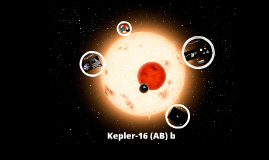An artist's rendering of the Kepler-16 system, showing the binary star being orbited by Kepler-16b. Credit: NASA/JPL-Caltech | |
| Observation data Epoch J2000 Equinox J2000 | |
|---|---|
| Constellation | Cygnus |
| Right ascension | 19h 16m 18.1759s[1] |
| Declination | +51° 45′ 26.778″[1] |
| Characteristics | |
| Spectral type | K / M[2] |
| Astrometry | |
| Proper motion(μ) | RA:14.041±0.054[1]mas/yr Dec.:−48.601±0.051[1]mas/yr |
| Parallax(π) | 13.2893 ± 0.0271[1]mas |
| Distance | 245.4 ± 0.5 ly (75.2 ± 0.2 pc) |
| Orbit[3] | |
| Primary | Kepler-16A |
| Companion | Kepler-16B |
| Period(P) | 41.079220 (± 0.000078) d |
| Semi-major axis(a) | 0.22431 (± 0.00035) AU |
| Eccentricity(e) | 0.15944 (± 0.00062) |
| Inclination(i) | 90.30401 (± 0.0019)° |
| Longitude of the node(Ω) | 0° |
| Periastronepoch(T) | BJD 2455212.12316 |
| Argument of periastron(ω) (secondary) | 263.464 (± 0.027)° |
| Details | |
| Kepler-16A | |
| Mass | 0.6897 (± 0.0035) M☉ |
| Radius | 0.6489 (± 0.0013) R☉ |
| Luminosity | 0.148[4]L☉ |
| Surface gravity(log g) | 4.6527 (± 0.0017) cgs |
| Temperature | 4450 (± 150) K |
| Metallicity [Fe/H] | -0.3 (± 0.2) dex |
| Rotation | 35.1 ± 1.0 days[5] |
| Kepler-16B | |
| Mass | 0.20255 (± 0.00065) M☉ |
| Radius | 0.22623 (± 0.00059) R☉ |
| Luminosity | ~0.0057[4]L☉ |
| Surface gravity(log g) | 5.0358 (± 0.0017) cgs |
| Temperature | ~3311[4]K |
| Other designations | |
Gaia DR2 2133476355197071616, KOI-1611, KIC 12644769, GSC 03554-01147, 2MASS J19161817+5145267[6] | |
| Database references | |
| SIMBAD | data |
| KIC | data |
Kepler 16 is a binary star system comprising of Kepler 16A and Kepler 16B, note that Kepler 16B is the star and Kepler 16b is the planet. Kepler 16A is an orange dwarf with 69% the mass of the sun, while Kepler 16B is a red dwarf with 20% the mass of the sun. The two stars are separated by a distance of 20.5 million miles (33 million km). Kepler-16 is an eclipsing binary star system in the constellation of Cygnus that was targeted by the Kepler spacecraft. Both stars are smaller than the Sun; the primary, Kepler-16A, is a K-type main-sequence star and the secondary, Kepler-16B, is an M-type red dwarf. Kepler 16 is a London-based software consultancy and professional network. We construct small, expert teams to tackle ambitious projects, solve hard problems and deliver solutions that scale. Why Work For Us Our Culture Our Engineering Processes Our Hiring Process. NASA's Kepler mission has turned fiction into fact. A world with a double sunset that was first imagined in 'Star Wars' over 30 years ago in a galaxy far, fa.
Kepler-16 is an eclipsingbinary star system in the constellation of Cygnus[7] that was targeted by the Kepler spacecraft. Both stars are smaller than the Sun; the primary, Kepler-16A, is a K-type main-sequence star and the secondary, Kepler-16B, is an M-type red dwarf. They are separated by 0.22 AU, and complete an orbit around a common center of mass every 41 days.
The system is host to one known extrasolar planet in circumbinary orbit: the Saturn-sized Kepler-16b.
Planetary system[edit]
Kepler-16b is a gas giant that orbits the two stars in the Kepler-16 system.[3] The planet is a third of Jupiter's mass and slightly smaller than Saturn at 0.7538 Jupiter radii, but is more dense. Kepler-16b completes a nearly circular orbit every 228.776 days.

| Companion (in order from star) | Mass | Semimajor axis (AU) | Orbital period (days) | Eccentricity | Inclination | Radius |
|---|---|---|---|---|---|---|
| b | 0.333 MJ | 0.7048 | 228.776 | 0.0069 | 90.032° | 0.7538 RJ |
References[edit]
- ^ abcdeBrown, A. G. A.; et al. (Gaia collaboration) (August 2018). 'Gaia Data Release 2: Summary of the contents and survey properties'. Astronomy & Astrophysics. 616. A1. arXiv:1804.09365. Bibcode:2018A&A...616A...1G. doi:10.1051/0004-6361/201833051.Gaia Data Release 2 catalog entry
- ^Jean Schneider (2011). 'Notes for star Kepler-16 (AB)'. Extrasolar Planets Encyclopaedia. Retrieved 23 September 2011.
- ^ abDoyle, Laurance R.; Carter, Joshua A.; Fabrycky, Daniel C.; Slawson, Robert W.; Howell, Steve B.; Winn, Joshua N.; Orosz, Jerome A.; Prša, Andrej; Welsh, William F.; et al. (2011). 'Kepler-16: A Transiting Circumbinary Planet'. Science. 333 (6049): 1602–6. arXiv:1109.3432. Bibcode:2011Sci...333.1602D. doi:10.1126/science.1210923. PMID21921192. S2CID206536332.
- ^ abcHaghighipour, Nader; Kaltenegger, Lisa (24 October 2013). 'Calculating the Habitable Zone of Binary Star Systems. II. P-type Binaries'. The Astrophysical Journal. 777 (2): 13. arXiv:1306.2890. Bibcode:2013ApJ...777..166H. doi:10.1088/0004-637X/777/2/166. S2CID118494204.
- ^Winn, Joshua N.; et al. (2011). 'Spin-Orbit Alignment for the Circumbinary Planet Host Kepler-16 A'. The Astrophysical Journal Letters. 741 (1). L1. arXiv:1109.3198. Bibcode:2011ApJ...741L...1W. doi:10.1088/2041-8205/741/1/L1.
- ^'Kepler-16'. SIMBAD. Centre de données astronomiques de Strasbourg. Retrieved 2020-08-09.
- ^Drake, Nadia. 'On Kepler-16b, shadows come in pairs'. Science News. Society for Science & the Public. Archived from the original on 28 August 2012. Retrieved 16 September 2011.
- ^Jean Schneider (2011). 'Notes for Planet Kepler-16 (AB) b'. Extrasolar Planets Encyclopaedia. Archived from the original on 11 October 2011. Retrieved 23 September 2011.
Kepler Planets
Coordinates: 19h 16m 18.17s, +51° 45′ 26.78″

Kepler 168f

Kepler 16 Ab B
